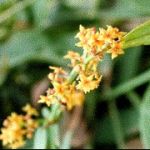| Common Name: |
Munjeet |
| Other Names: |
Indian Madder, Manjishta |
| Botanical Name: |
Rubia cordifolia syn. R. manjith |
| Genus: |
Rubia |
| Family: |
Rubiaceae |
| Native Location: |
Mountainous regions of Asia, from the Himalayas to Japan, extending into SE Asia and tropical Africa |
| Cultivation: |
Well-drained soil in sun or partial shade. Rubia tinctorum prefers light, dry soil, and thrives in alkaline conditions. |
| Propagation: |
By seed sown when ripe; by division in spring. |
| Harvest: |
Rhizomes and roots are lifted in autumn from plants at least three years old, and peeled and dried for decoctions and powders. Chinese herbalists also lift roots in spring. Whole plants, including roots, are lifted from two-year-old plants in spring or autumn for dye production. |
| Height: |
6m (20ft) |
| Hardiness: |
Z6 |
| Warning: |
Internal use of madders stains urine, milk, and bones red |
| Parts Used: |
Whole plant, roots (qian cao gen) |
| Properties: |
A bitter-sweet, cooling herb that is diuretic and expectorant, checks bleeding, controls coughing, reduces inflammation, and has anti-bacterial effects (Chinese medicine). It also stimulates the circulation, dissolves and inhibits formation of kidney stones, and has alterative effects (Ayurvedic Medicine). |
| Medicinal Uses: |
Internally for abnormal uterine bleeding, internal and external hemorrhage, bronchitis, and rheumatism (Chinese medicine); menstrual and menopausal complaints, jaundice, hepatitis, kidney stones, bladder stones, and gallstones, herpes, skin complaints and dysentery (Ayurvedic medicine). Externally, combined with honey for skin inflammations and with Glycyrrhiza glabra (See, Licorice) for burns and injuries (Ayurvedic medicine). |
| Ecomonic Uses: |
Source of natural and red dyes |
| Bibliography: |
The Encylopedia of Herbs by Deni Brown Copyright © 1995, 2001. Dorling Kindersley Limited. pg 349 |

